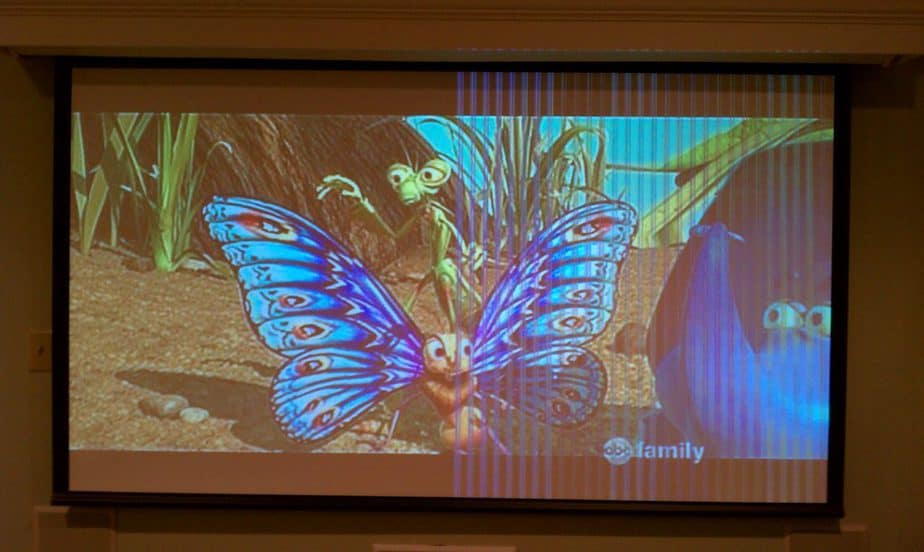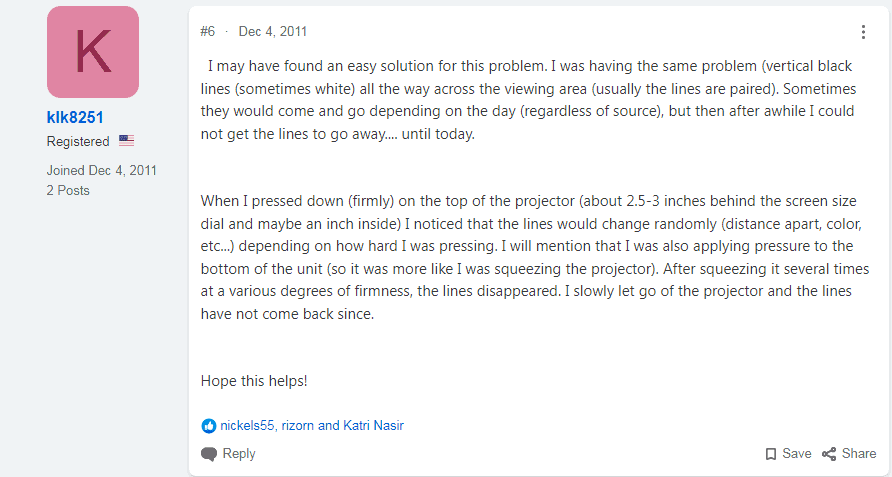When projected, lines may show across the image. The Projector lines could be vertical horizontal, vertical, horizontal or black, white or in other colors. They could be a part of the entire image or appear only on part of the image.
There are many reasons as to which could explain why this white vertical lines appear. There could be caused by a problem in the poorly connected cables or internal components or bad solder.

Every device is 100% perfect. Your device could have problems, like experiencing color lines in your screen. This is just one of many issues you are able to solve by yourself prior to taking on device repair.
How Can Remove Those Vertical Projector Lines?
1.Adjust Settings
It is possible that the video interlacing process for an Epson projector model might require to be “cleaned,” much like the traditional VHS player. Utilize to press the “Tracking” button on the remote control or the control panel as it usually removes the lines and resolves any problems with de-interlacing. If this isn’t working you can click “Signal,” and then switch on “Auto.” This setting detects automatically the kind of input device the projector shows video for, and alters the way in which your device determines video signals.
If you’re projecting from a computer , and projecting an image which has many fine details there could be vertical bands or the characters could appear dense or blurred. Use the Auto button on the remote control to reset the projector’s tracking and sync settings.
If further adjustments are required it is possible to fine-tune the tracking or the Sync settings by hand using the Signal menu on the projector.
- The screen with the screen with an image that has fine detail like a pattern, to make it appear as a background for your desktop or even projecting black text onto white backgrounds.
- Modify your tracking to remove vertical bands.
- Adjust the setting to Sync. setting to improve the image clarity.
2.Check Input Cables
Examining the input cables requires two steps: ensuring that all video cables are properly set, and then manually setting the display signal. Remove all video cables such as HDMI and VGA to the front of the projector Then, reconnect each cable in a series and check whether vertical lines go away. If not, go into the “Signal” setting in the control panel and select manually your video output type.
Check that you have cables have been securely connected to both ends.
When you’re connecting an extension cable it is possible to encounter interference if your cable isn’t adequately protected. You might need an signal amplifier to accommodate longer cables.
3.Hold It Down On The Projector Securely.
This is an easy and simple method of getting free of vertical lines which are visible in your projector. Although it’s not completely evident how it works the method works, it is effective.
Make sure you press downwards on top of the projector. Your thumbs should be placed about 2.5 or 3 inches in front of on the screen size dial and press the projector one inch inside. In addition, press the bottom of your projector and place pressure on both the bottom and top. This will feel similar to pressing the projector. Be careful about the pressure you press.
If you press down on the projector in this manner you’ll notice that the lines could change randomly based upon how hard you press. The lines get further apart and the color could alter.
Continue to apply pressure on the projector Do this at various degrees of the firmness. After a few minutes you’ll notice how the vertical lines have disappeared. At this point you are able to put your finger down, and then slowly let go of your projector.

4.Repair Clean And Replace Your Mainboard
The mainboard is the part of the projector which controls its internal functions. It’s comprised of electronic components along with chips that perform major tasks including controlling the image engine and controlling its fan.
Sometimes, damage caused to the mainboard manifests in the form of vertical white lines across the projected image. It could be caused by the result of a crack which was created in the previous repair.
There are a variety of options for you to fix this. You could choose the option to repair any damage, or repair the whole mainboard.However in the event that there isn’t anything obvious issue with the motherboard, follow these easy steps.
This is because the DLP projector chip connects to one of the edges connector in the primary board. Cooling and heating cycles and oxygenation can damage this connection.
If you took out the primary board out, use some little deoxit on the connector and then put it back in place. An easy and common fix issue.
Similar to the beginning PC times when it was commonplace to remove and re-seat different cards in order to wipe contacts clean. contacts clean.
If there is only one line of solid vertical or horizontal lines in the image it’s an indication that one of the following is true:
1.) There is a problem within the DMD elastomer (socket that the DMD is seated in)
2.) Cable Connection Issues Between the DMD/Engine and Main ECA in which the DMD Control devices from TI are located.
3.) Possibly several affected DMD pixels (cluster) this is when the mulitpole pixels fail together. If this happens, it causes the row or column in the entoire to appear as an uninspiring line (off condition). If this happens the solution is to replace the DMD chip that is expensive.
5.Contact Customer Support
If nothing else works and all else fails, the customer support department can be an unstoppable source of advice on troubleshooting (see the Resources). If they don’t have any other ideas for repairing the device. They can arrange to ship the projectors into one of their own in-house or accredited repair centers.
